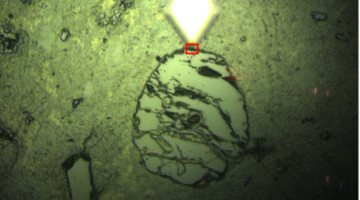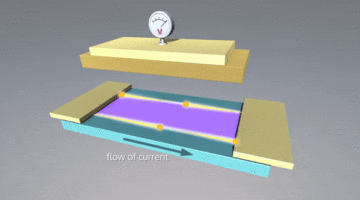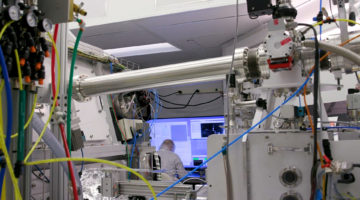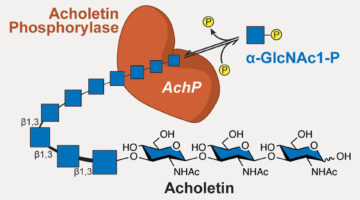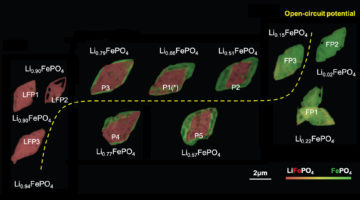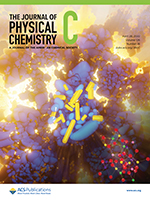Using a nanoscale infrared probe, researchers found that the minerals in a meteorite—an artifact representing the solar system’s past—were altered by water on very fine spatial scales. The work sheds light on conditions in the early solar system and lays groundwork for analyzing asteroid samples to be returned to Earth by NASA in 2023. Read more »![]()
![]()
A Topological-Insulator Sandwich for Efficient Microelectronics
Researchers synthesized a topological insulator between two ferromagnetic layers and found that it is electronically characterized by a large magnetic band gap. The results open a new path toward lossless charge transport and perfect spin polarization, which could lead to the development of ultralow-energy electronics and spintronics. Read more »![]()
![]()
Decoupling the metal–insulator transition temperature and hysteresis of VO2 using Ge alloying and oxygen vacancies
The VO2 metal–insulator transition underpins applications in thermochromics, neuromorphic computing, and infrared vision. Ge alloying is shown to expand the stability of the monoclinic phase to higher temperatures, and by suppressing the propensity for oxygen vacancy formation, renders the hysteresis of the transition exquisitely sensitive to oxygen stoichiometry. Read more »
Removing Nitrogen from Wastewater using Horizontal Levees
Treated municipal wastewater often contains nitrogen, which has been linked to algal blooms that can devastate coastal ecosystems. In a recent study, researchers characterized the primary nitrogen-removal pathways in a horizontal levee, an engineered subsurface water-treatment system consisting of a gently sloping strip of land adjacent to storm-control levees. Read more »
Pushing the Boundaries of Moore’s Law: How Can Extreme UV Light Produce Tiny Microchips?
For the past 25 years, scientists and engineers from the Center for X-Ray Optics (CXRO) have worked to develop EUV lithography, a technique that enables microchip circuits and transistors that are tens of thousands of times thinner than a strand of human hair. Patrick Naulleau, a CXRO scientist who helped develop EUV lithography, shares his perspective in this Q&A. Read more »
ALS in the News (May 2022)
-
-
-
- Not just pollen in the spring: Wild grass releases a variety of particles into the air
- DOE Office of Science budget: FY22 outcomes and FY23 request
- Senate confirms Berhe as federal Office of Science director
- Four Berkeley Lab scientists elected to the American Academy of Arts and Sciences
- Physics Ph.D. student awarded fellowship at Berkeley Lab
- 75 Years of Science with Synchrotron Light (lightsources.org virtual symposium recording)
- Unlocked enzyme structure shows how strigolactone hormone controls plant growth
-
-
Bacterial Enzyme Produces Biodegradable Polymer
Researchers discovered a bacterial enzyme that synthesizes a biopolymer whose repeating units are linked together in way that had not been previously observed. The new polymer is biodegradable and may be biocompatible, with potential for applications ranging from medical therapeutics to eco-friendly plastic alternatives. Read more »![]()
![]()
A Machine-Learning Approach to Better Batteries
Researchers extracted the relationship between strain and composition in a battery material by applying machine-learning methods to atomic-scale images. The work could lead to more durable batteries and also highlights the potential of integrating microscopy techniques with machine learning to gain insights into complex materials. Read more »![]()
![]()
Looking Inside a Battery with Infrared Light
Researchers have developed a new infrared methodology with unparalleled spatial and chemical imaging capabilities that helps to characterize processes at the interfaces between electrodes and electrolytes, with an eye toward bringing increased safety, lifetime, and energy density to the next-generation solid-state battery market. Read more »
Exploring Critical Synthetic Parameters for Nanoscale ε-Fe2O3 and Their Influence on Magnetic Behaviors
An intermediate polymorph of iron oxide, ε-Fe2O3, has attracted significant attention for potential applications in high-frequency mm-wave absorption and high-density magnetic recording. However, fabrication is still a challenge. Here, we identified critical reaction parameters to improve the phase purity and tested their effects. Read more »
- « Previous Page
- 1
- …
- 22
- 23
- 24
- 25
- 26
- …
- 83
- Next Page »
